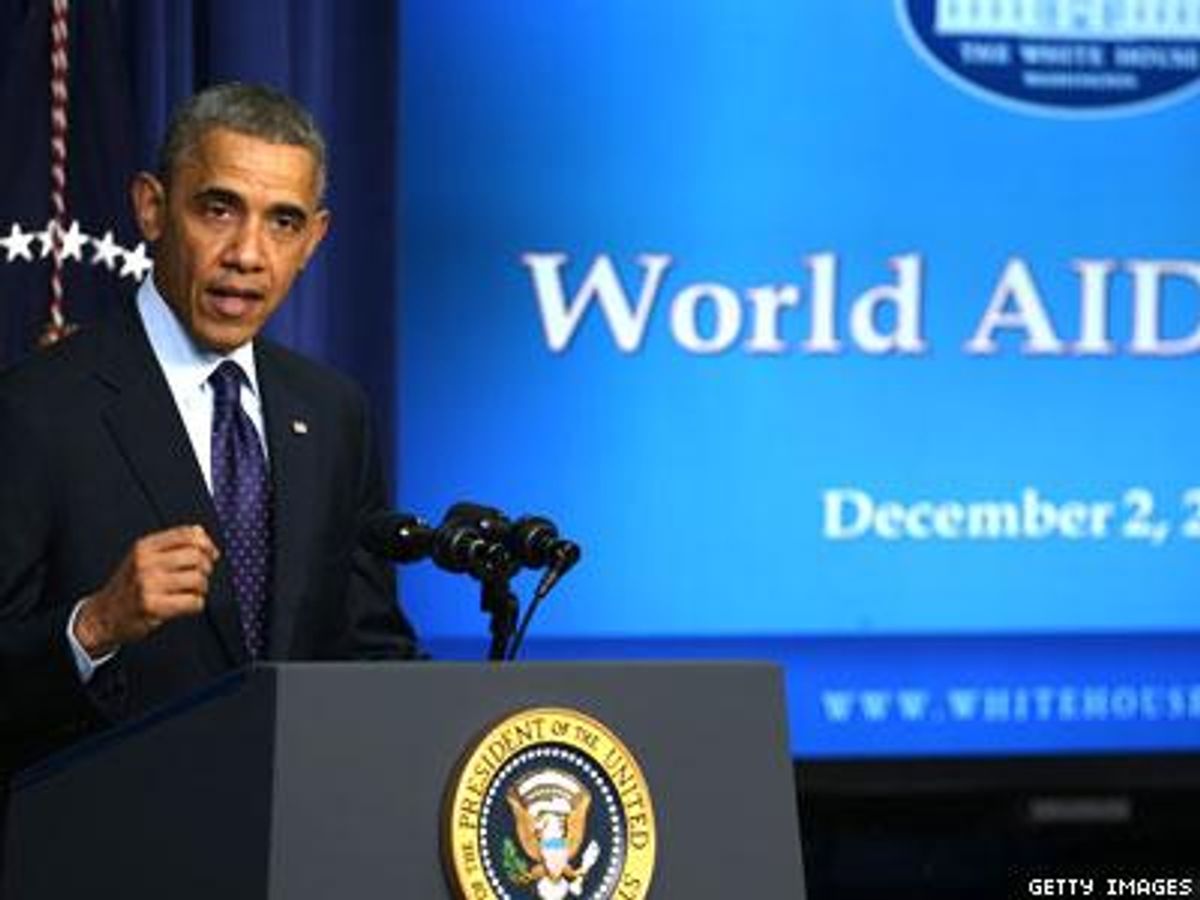President Obama officially observed World AIDS Day this morning, speaking to reporters about the progress made globally in both understanding and treating HIV and AIDS. According to White House pool reporter Jared A. Favole, of The Wall Street Journal, Obama said while the disease was once a death sentence that took people in their prime, today people can live vibrant and healthy lives.
He also talked about pledging $100 million to the National Insititute of Health to help find a cure for HIV and AIDS and matching contributions of partner countries two to one for up to $5 billion, money that would go to the Global Fund to Fight AIDS, Tuberculosis, and Malaria.
Obama's full speech (printed below) is followed by a memo titled "Shared Responsibility to Strengthen Results for an AIDS-Free Generation," that the White House also released today.
President Obama's full remarks on World AIDS Day:
"Thank you, everybody. (Applause.) Everybody, please have a seat. Well, thank you, Grant, for your outstanding leadership of the Office of National AIDS Policy. And thanks to all of you for being here. This is a pretty distinguished crowd, I have to say, and it is wonderful to be here.
I should say, actually, welcome back, because many of you have joined us before as we’ve marked new milestones in our fight against HIV and AIDS. And I’m honored that you could join us in commemorating World AIDS Day, which was yesterday. And this is a time for remembering the friends and loved ones that we’ve lost, celebrating the extraordinary progress -- thanks to some people in this room -- that we’ve been able to make, and most importantly, recommitting ourselves to the mission that we share, which is achieving an AIDS-free generation.
I especially want to welcome ministers from our partner countries; members of my administration, including Secretary Sebelius, Secretary John Kerry; Congresswoman Barbara Lee; Mark Dybul from the Global Fund to Fight AIDS, Tuberculosis and Malaria. And we’ve also got here Francis Collins from the National Institutes of Health; Michel Sidibe from UN-AIDS; Deborah von Zinkernagel, who’s carrying on the great work of Eric Goosby as our Acting Global AIDS Coordinator; and our many friends from the philanthropic world, including Bill Gates. So thank you all for joining us here today.
Every year, this is a moment to reflect on how far we’ve come since the early days of the AIDS epidemic. And those of you who lived through it remember all too well the fear and the stigma, and how hard people with HIV had to fight to be seen, or heard, or to be treated with basic compassion. And you remember how little we knew about how to prevent AIDS, or how to treat it. What we did know was the devastation that it inflicted -- striking down vibrant men and women in the prime of their lives and spreading from city to city and country to country seemingly overnight.
Today, that picture is transformed. Thanks to the courage and love of so many of you in this room and around the world, awareness has soared; research has surged. Prevention, treatment and care are now saving millions of lives not only in the world’s richest countries but in some of the world‘s poorest countries as well. And for many, with testing and access to the right treatment, the disease that was once a death sentence now comes with a good chance at a healthy and productive life. And that's an extraordinary achievement.
As President, I’ve told you that in this fight, you’ll have a partner in me. And I said that if the United States wanted to be the global leader in combating this disease, then we needed to act like it -- by doing our part and by leading the world to do more together. And that’s what we’ve done, in partnership with so many of you. We created the first comprehensive National HIV/AIDS Strategy, rooted in a simple vision that every person should get access to life-extending care, regardless of age or gender, race or ethnicity, sexual orientation, gender identity or socio-economic status.
We’ve continued to support the Ryan White CARE Act to help underserved communities, and we lifted the entry ban so that people with HIV are no longer barred from the United States -- which led to the International AIDS Conference being held here last year for the very first time in over 20 years.
This summer, I issued an executive order creating the HIV Care Continuum Initiative to boost our federal efforts to prevent and treat HIV. Last month, I signed the HIV Organ Policy Equity Act, to finally allow research into organ donations between people with HIV -- a step achieved with bipartisan support.
And thanks to the Affordable Care Act, millions of insured Americans will be able to get tested free of charge. Americans who were uninsured will now be able to have access to affordable health care coverage, and beginning in January, no American will be again denied health insurance because of their HIV status.
On World AIDS Day two years ago, I announced an additional $35 million for the AIDS Drug Assistance Program, which helps people pay for lifesaving medications. At one time, the need was so great that over 9,000 people were on the waitlist. We vowed to get those numbers down. And I’m proud to announce that, as of last week, we have cleared that waitlist. We are down to zero. (Applause.) And we’re going to keep working to keep it down.
So we’re making progress. But we’re all here today because we know how much work remains to be done. Here in the United States, we need to keep focusing on investments to communities that are still being hit hardest, including gay and bisexual men, African Americans and Latinos. We need to keep up the fight in our cities -- including Washington, D.C., which in recent years has reduced diagnosed infections by nearly half.
And we’re going to keep pursuing scientific breakthroughs. Today I’m pleased to announce a new initiative at the National Institutes of Health to advance research into an HIV cure. We’re going to redirect $100 million into this project to develop a new generation of therapies. Because the United States should be at the forefront of new discoveries into how to put HIV into long-term remission without requiring lifelong therapies -- or, better yet, eliminate it completely.
And of course, this fight extends far beyond our borders. When I became President, I inherited President Bush’s phenomenal program, PEPFAR, which has helped millions around the world receive lifesaving treatment. And we haven’t just sustained those efforts, we’ve expanded them -- reaching and serving even more people, especially mothers and children. Earlier this year, PEPFAR reached a wonderful milestone -- the one millionth baby born without HIV. (Applause.) And that alongside the rapid decline in new HIV infections and deaths from AIDS in sub-Saharan Africa.
On my visit to South Africa this year, I visited a clinic run by Bishop Desmond Tutu and had the honor of spending time with some of their extraordinary young patients and counselors and outreach workers and doctors. Every day, they are doing extraordinary work. And when you visit this facility, you cannot help but be inspired by what they do each and every day, in part thanks to the support of the United States of America. They’re saving lives and they’re changing the way their country, and the world, approaches this disease. And that’s work that we have to continue to advance.
On World AIDS Day two years ago, I set new prevention and treatment targets for PEPFAR, like increasing the number of mothers we reach so that we prevent their children from becoming infected, and helping 6 million people get treatment by the end of 2013. Today, I’m proud to announce that we’ve not only reached our goal, we’ve exceeded our treatment target. So we’ve helped 6.7 million people receive lifesaving treatment. And we’re going to keep at it. (Applause.) Which is why, after I leave here today, I’ll be proud to sign the PEPFAR Stewardship and Oversight Act, to keep this program going strong. (Applause.) Count on the legislator to applaud legislation. (Laughter.)
Looking ahead, it’s time for the world to come together to set new goals. Right now we’re working hard to get a permanent leader in place at PEPFAR, and once we do, one of our first items of business will be convening a meeting early next year, so the United States and our partners worldwide -- including governments, the Global Fund, U.N.-AIDS, and civil society -- can sit around one table and develop joint HIV prevention and treatment goals for the countries where we and the Global Fund do business. We’ll hold each other accountable, and we’ll continue to work to turn the tide of this epidemic together.
And that includes keeping up our support for the Global Fund. Its success speaks for itself. It’s helping over 6 million people in over 140 countries receive antiretroviral therapy. And now it’s time to replenish the Fund. The United States will contribute $1 for every $2 pledged by other donors over the next three years, up to $5 billion total from the United States. And the United Kingdom has made a similar promise. (Applause.)
So today I want to urge all those who are attending the Global Fund’s replenishment meetings both today and tomorrow to take up this commitment. Don’t leave our money on the table. It’s been inspiring to see the countries most affected by this disease vastly increase their own contributions to this fight -- in some cases, providing more than donor countries do. And that ought to inspire all of us to give more, to do more, so we can save more lives.
After all, none of the progress we’ve made against AIDS could have been achieved by a single government or foundation or corporation working alone. It’s the result of countless people -- including so many of you -- working together from countries large and small, philanthropies, universities, media, civil society, activists. More than anything, I think it’s thanks to the courageous people living with HIV around the world who’ve shared their stories; you’ve lent your strength, demanded your dignity be recognized, and led the fight to spare others the anguish of this disease.
We can’t change the past or undo its wrenching pain. But what we can do -- and what we have to do -- is to chart a different future, guided by our love for those we couldn’t save. That allows us to do everything we can, everything in our power to save those that we can. And that’s my commitment to you as President.
The United States of America will remain the global leader in the fight against HIV and AIDS. We will stand with you every step of this journey until we reach the day that we know is possible, when all men and women can protect themselves from infection; a day when all people with HIV have access to the treatments that extend their lives; the day when there are no babies being born with HIV or AIDS, and when we achieve, at long last, what was once hard to imagine -- and that’s an AIDS-free generation.
That’s the world I want for my daughters. That’s the world that all of us want for our families. And if we stay focused, if we keep fighting, and if we honor the memory of those that we’ve lost, if we summon the same courage that they displayed, by insisting on whatever it takes, however long it takes, I believe we’re going to win this fight. And I’m confident that we’ll do so together.
So thank you very much for your extraordinary efforts. Appreciate it. God bless you. Thank you. Thank you. "
White House memo: "Shared Responsibility to Strengthen Results for an AIDS-Free Generation"
Since taking office, President Obama and his Administration have taken enormous steps to address the HIV epidemic, both domestically and globally. This World AIDS Day, we remember those lost to this epidemic, and reflect on the progress of the past year to prevent HIV infections, improve the health of people living with HIV worldwide, and address HIV stigma and discrimination. Earlier this year, PEPFAR celebrated its tenth anniversary. Domestically, we are refocusing our efforts to lower new HIV infections, improve health outcomes, and reduce disparities. In July, President Obama signed an Executive Order to launch the HIV Care Continuum Initiative, the next step in implementing the National HIV/AIDS Strategy.
Global Leadership on HIV/AIDS
The Obama Administration has strengthened the impact and sustainability of the President’s Emergency Plan for AIDS Relief (PEPFAR) and led efforts to reform and drive increased investments in the Global Fund to Fight AIDS, Tuberculosis and Malaria. The U.S. was the largest donor to HIV efforts in low- and middle-income countries in 2012, accounting for 64% of total international assistance for HIV/AIDS. Together, the PEPFAR and the Global Fund account for over 90% of donor funding for the AIDS response in the world’s highest-burdened and lowest-resourced countries. PEPFAR and the Global Fund are working together to invest resources in a coordinated, complementary, and synergistic manner to combat HIV/AIDS.
PEPFAR has delivered on the President’s 2011 World AIDS Day targets:
PEPFAR has exceeded the President’s 2011 World AIDS Day target to put 6 million people on lifesaving treatment. As of September 30, 2013, PEPFAR is supporting treatment for 6.7 million people. This signifies an almost four-fold increase (from 1.7 million in 2008 to 6.7 million in 2013) since the start of the Obama Administration.
PEPFAR has reached the prevention of mother-to-child transmission target by reaching 1.5 million pregnant women with HIV with antiretroviral drugs to prevent HIV transmission to their children.
As of September 30, 2013, PEPFAR will have directly supported more than 4.2 million voluntary medical male circumcision procedures worldwide, and by the end of calendar year 2013, PEPFAR will have reached the President’s target of 4.7 million.
In June 2013, we reached the one millionth infant born HIV-free because of PEPFAR support. In Fiscal Year 2013 alone, PEPFAR’s investments meant that over 240,000 babies were born HIV-free.
The most recent UNAIDS data shows that, in sub-Saharan Africa, the number of AIDS-related deaths decreased by 32% from 2005 to 2012, and the number of new HIV infections fell by nearly 39% from 2001 to 2012, due in large part to the efforts of PEPFAR and the Global Fund.
PEPFAR’s success in treating 6.7 million people with HIV has helped to drive down new infections and AIDS-related deaths in many PEPFAR-supported countries. To address the high rates of HIV in key populations, PEPFAR supports initiatives to end stigma and discrimination against people living with HIV and key populations, improving their access to, and uptake of, comprehensive HIV services. As outlined in the PEPFAR Blueprint, to prevent the spread of HIV, PEPFAR will continue to make strategic, scientifically sound investments to expand core HIV prevention, treatment and care interventions and maximize impact.
U.S. Investment in the Global Fund
The U.S. has been the largest donor to the Global Fund, contributing $8.5 billion to date. The Global Fund is a vital partner to the United States in supporting a country-owned response to AIDS, tuberculosis (TB), and malaria. The Obama Administration has driven transformational reforms of the Global Fund, tying its last pledge to development and implementation of a comprehensive reform agenda, and conditioning its current pledge to successful execution of critical reforms. The Administration’s goal is to further secure the Global Fund’s role as an efficient, accountable and results-driven mechanism to fight HIV/AIDS, TB and malaria.
In 2010, following our successful three-year, $4 billion pledge to the Global Fund for FY 2011-2013, the President’s FY 2014 Budget requested $1.65 billion for the Global Fund. To leverage future funding from other donors, the U.S. announced that its commitment for the 2014 replenishment is conditional on other donors’ stepping up their contributions to match the U.S. investment two-to-one, and the Global Fund's continuing implementation of its ambitious reform agenda. The U.S. will match incoming contributions to the Global Fund through September 2014 and will provide 33% of investments in the Global Fund for the 2014-2016 replenishment. As of December 2013, the Global Fund reports that supported programs have helped:
· 6.1 million people receive antiretroviral treatment for HIV/AIDS;
· Detect and treat 11.2 million new cases of infectious TB; and
· Distribute 360 million bed nets to protect families from malaria.
The National HIV/AIDS Strategy
To reinvigorate leadership and accountability in the domestic response to HIV, in 2010 President Obama released the first comprehensive National HIV/AIDS Strategy, which has four primary goals: to reduce new HIV infections; to improve health outcomes for people living with HIV; to reduce HIV-related health disparities and inequities; and to achieve a more coordinated national response to the epidemic. Ongoing implementation of the Strategy means:
· Focusing on science-driven HIV prevention efforts by supporting and expanding targeted use of evidence-based HIV prevention approaches;
· Making smarter investments by intensifying HIV prevention in the communities where HIV is most heavily concentrated;
· Increasing access to HIV screening and medical care, including through implementation of the Affordable Care Act;
· Supporting a shared response to the domestic epidemic through the support of HIV prevention efforts across all levels of society, including Federal, state, and local governments, centers of learning, faith-based communities, and the private sector.
The President’s proposed FY 2014 budget allocated $23.2 billion to address HIV domestically, and includes increases in discretionary funding for HIV prevention, care, and treatment.
Moving Forward
In July 2013, the President signed an Executive Order creating the HIV Care Continuum Initiative. The initiative calls for coordinated action in response to data that shows only a quarter of people living with HIV in the United States have achieved the treatment goal of controlling the HIV virus. In fact, along the entire HIV care continuum—the sequential stages of care from being diagnosed to suppressing the virus—there are significant gaps. To address this need, the HIV Care Continuum Initiative is mobilizing Federal efforts in line with the recent advances in our understanding of how best to prevent and treat HIV infection.
Today, the White House released the report Improving Outcomes: Accelerating Progress Along the HIV Care Continuum. The report has four main sections:
I. State of the Epidemic: Provides an update on the Strategy’s indicators. There’s been positive progress in eight of nine indicators, with one stable. Overall, our collective response to the epidemic will need to accelerate to meet all nine 2015 Strategy targets. The data are from 2010 and 2011, so cannot be used to grade the success of the Strategy. Instead, they are the most recently available data that give an accurate assessment of the domestic epidemic.
II. Recommendations of the HIV Care Continuum Working Group: Describes actions Federal agencies will take to improve outcomes along the HIV Care Continuum. Recommendations focus on supporting innovative models of HIV care; addressing stigma that limits engagement in care; strengthening data collection; promoting research to better address barriers to care; and providing technical assistance to improve care continuum outcomes.
III. Local Success: Highlights the progress of Washington D.C., San Francisco, and New York City. These jurisdictions implemented approaches that are consistent with the principles of the Strategy (widespread access to treatment and testing, focusing on populations at greatest risk). They are reporting tangible improvements in HIV prevention and treatment outcomes.
IV. Public-Private Partnerships: Describes examples across the country of innovative projects supporting improvements along the care continuum. This includes work being done in partnership with Social Innovation fund, industry, and local community-based organizations.
Investing in research to improve treatments for HIV: The HIV Cure Initiative
Better treatments mean better outcomes along the care continuum; a cure represents the ultimate outcome in that regard. Today, President Obama announced that the National Institutes of Health (NIH) will invest $100 million in reprioritized funding over the next three years to launch a new HIV Cure Initiative.
· Although several individuals appear recently to have been cured of HIV through aggressive therapy, these approaches are too toxic or premature to apply beyond the research setting.
· However, these cases provide clues to explore for possible new treatments, including other strategies that may eliminate or put HIV into remission without requiring lifelong therapy.
· This new investment will catalyze further research into this area, and could lead to a new generation of therapies to improve outcomes for people living with HIV.
Activities across the Federal Government are already working to help improve outcomes across the HIV care continuum. Examples include:
· Increasing healthcare coverage: The Affordable Care Act will expand health insurance coverage to millions of Americans, including thousands living with HIV. Under the law, starting in 2014 new health insurance plans will be required to cover HIV testing without additional out-of-pocket costs. Starting in 2014, insurance companies cannot deny coverage based on pre-existing conditions, including HIV.
· Maintaining strong support for the Ryan White Program: The Ryan White Program is the largest Federal program solely dedicated to providing HIV care and treatment. The Ryan White Program will continue to play a vital role in completing coverage and ensuring people living with HIV continue to receive treatment without service gaps. With support of ongoing supplemental investments from the Administration, the number of people living with HIV on waiting lists for the joint state-Federal AIDS Drug Assistance Program decreased from a peak of 9,310 in September 2011 to zero as of November 27, 2013. Sustaining this momentum will require continued effort, including ongoing partnership with States and Congress enacting a budget that replaces the sequester in a balanced, fiscally responsible manner.
· Supporting innovation to link and engage persons living with HIV into care: Funded through the Secretary's Minority AIDS Initiative Fund, the Care and Prevention of HIV in the United States demonstration project is underway in eight states and is designed to reduce HIV-related morbidity, mortality, and related health disparities among racial and ethnic minorities.
· Focusing on prevention interventions that work: CDC and its partners are pursuing a High-Impact Prevention approach to reducing new HIV infections. This approach is using combinations of scientifically proven, cost-effective, and scalable interventions targeted to the right populations in the right geographic areas to increase the impact of HIV prevention efforts. CDC funded programs conducted more than 3.5 million HIV tests in 2012 and newly diagnosed more than 13,000 people.
· Standardizing HIV data to improve health outcomes along the care continuum: In June 2013, the Secretary of Health and Human Services approved plans submitted by nine HHS operating divisions to adopt and deploy seven HIV common core indicators and streamline data collection for HIV services grantees. HHS offices are working to include these indicators as clinical quality measures in electronic health record systems beginning in 2016.
· Supporting research to improve outcomes along the HIV care continuum: The NIH has expanded its investment in research to address gaps and opportunities in the HIV care continuum. Highlights include investigations of the effectiveness of methods to identify people living with HIV earlier and to link them to care; community-level interventions to expand HIV testing and treatment; interventions to improve HIV outcomes among substance users; and evaluation of innovative network approaches for HIV testing and referral for uninfected persons in the correctional system.
· Supporting HIV prevention, care and treatment for veterans living with HIV/AIDS: The Department of Veterans Affairs (VA) is focusing on increasing HIV testing rates and the number of veterans who are aware of their HIV status and linked to care and treatment. Since the release of the Strategy, the VA has increased the number of veterans screened for HIV by 217%.
· Addressing HIV-related stigma and discrimination: Stigma and discrimination keep people from getting tested, care and treatment. The Department of Justice (DOJ) will continue its aggressive HIV non-discrimination enforcement efforts, specifically targeting enforcement and outreach to the geographic areas with the highest prevalence of HIV, and continue its efforts to address HIV criminalization laws. DOJ will also increase its work under the Barrier-Free Health Care Initiative, which focuses on removing barriers to health care for people with HIV. The Federal Bureau of Prisons will continue its efforts to maximize optimal HIV treatment for inmates and improve clinical linkages upon their release.
· Increasing employment opportunities for people living with HIV/AIDS: The Department of Labor (DOL) continues to support efforts in this regard. Efforts specific to HIV include publishing a suite of “Employment and Living with HIV/AIDS” materials, including a resource guide for individuals; a business case for employers; a series of individual, employer and service provider success stories; and an online toolkit with information for individuals, employers and service providers.
· Supporting stable housing for people living with HIV/AIDS: Ongoing support of the Housing Opportunities for People with AIDS (HOPWA) program and other HUD programs means thousands of people living with HIV and their families have stable housing, which is vital to improving health and wellness. HOPWA currently supports housing for over 61,614 households.







































































